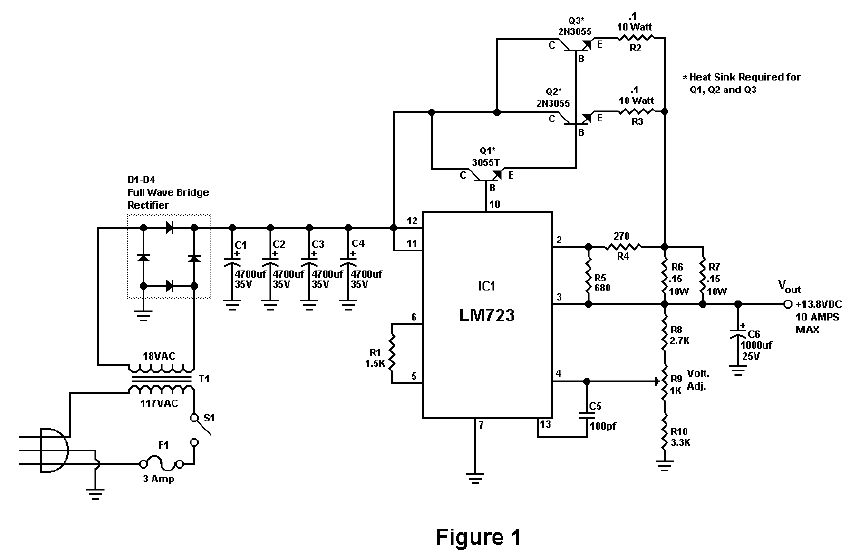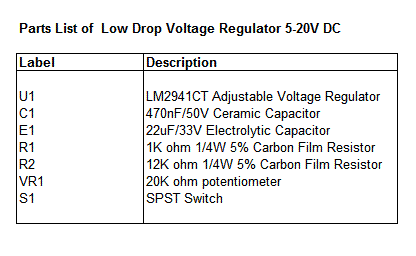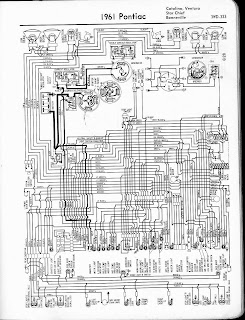Saturday, October 18, 2014
VGA pinout Diagram
2 - green out 7 - green return (ground)
3 - blue out 8 - blue return (ground)
4 - unused 9 - no pin
5 - ground 10 - sync return (ground)
11 - Monitor ID Bit 0
12 - monitor id 1 in or data from display
13 -horizontal sync out
14 - vertical sync
15 - monitor id 3 in or data clock
Simple 100W Guitar Pre Amplifier Circuit Diagram
one - IC pin outs are industry standard for dual op amps - pin four is -ve supply, and pin 8 is +ve supply.
two - Op amp supply pins must be bypassed to earth with 100nF caps (preferably ceramic) as close as feasible to the op amp itself.
three - Diodes are 1N4148, 1N914 or similar.
four - Pots ought to be linear for tone controls, & log for volume and master.
If the bright switch is bright ( much treble), increase the 1k resistor (R5) to tame it down again. Reduce the worth to get more bite. The tone control arrangement shown will give zero output if all controls are set to maximum - this is unlikely to be a common requirement in use, but be aware of it when testing.
The input, effects & output connections are shown in Figure 1B.

This is the reference for all zero volt returns, including the 0.1 ohm speaker feedback resistor. Dont connect the feedback resistor directly to the amps GND point, or you will generate distortion & feasible instability. The supply for the amp & preamp must be taken directly from the filter caps - the diagram above is literal - that means that you follow the path of the wiring as shown. Although mentioned above, you might well ask why the pots dont mount directly to the PCB to save wiring. Simple . Had I done it that way, you would require to make use of the same type pots as I designed for, & the panel layout would must be the same , with the exact same spacings. I figured that this would be limiting, so wiring it is. The wiring actually doesnt take long & is simple to do, so is not an issue. I didnt include the "Bright" switch in Figure 1B for clarity. I expect that it will cause few issues.
Friday, October 17, 2014
Homemade transistor from a photocell
Normally used to detect light, the photocell is pretty close to what one would need to make a transistor. The device consists of two pieces of metal that are separated by a very thin layer of a cadmium sulfide semiconductor. The semiconductor is normally an insulator, which means that no electricity can flow from one of the metal legs to the other. However, when light (photons) hit the surface of the semiconductor, they knock electrons free, and allow some current to flow across the semiconductor. To make a transistor, though, the device needs to react to electricity, not light. Nyle realized that the photocell could be used as a transistor if an insulated gate was added to the top of it. A bit of scotch tape and water later, and he claims to have a working transistor.
Of course, this isn’t a truly homemade transistor, it’s more of a DIY transistor conversion. The device appears to be functional, however it requires fairly high voltages to work, and only acts as a power amplifier instead of a voltage amplifier. Even so, it looks like an interesting way to experiment with transistors at home. I’d like to build one, and vary thickness of the insulator (scotch tape) to see what the results are. Anyone else have experience with this?
13 8 Volt 10 Amp Power Supply


Cheap Bicycle Alarm Schematics Circuit
Cheap Bicycle Alarm Circuit diagram :
Latest New Motorola Hi Fi power amplifier


This is a very simple, low cost, Hi-Fi quality power amplifier. You can build it 5 ways, like it?s shown in the table (from 20 W to 80 W RMS).
Some comments:
- The first thing that you must do, is to measure the end transistors (T3 and T4) amplifying coefficient, the hfe or ?. If their disagreement is bigger than 30 %, the amplifier would not give a clear sound. I used MJ3001 and MJ2501 transistors, and this disagreement was around 5%.
- Before the first ?turning on? you must short circuit the inputs of the amp, and put a mA-meter on the output, than turn the amplifier on, and tune the R13 pot, to decrease the DC current on the output, to some uA-s, or in a lucky situation to zero. I was able to decrease it to 10 uA.
Lighting Up Model Aircraft
Simple Solar Cell Voltage Regulator Circuit Diagram
Thursday, October 16, 2014
Variable 5 to 20V DC Supply Circuit Diagram
Variable 5 to 20V DC Supply Circuit Diagram
If R1=1K, Vout = 5V, VR1 should be set to 2.9K ohm.
If R1=1K, Vout = 20V, VR1 should be set to 14.7K ohm
Diagram 1961 Pontiac Catalina, Ventura, Star Chief,
Build a Compressor Circuit with 570 571 Compandor IC
Compressor Circuit with 570/571
Simple 30 Watt VHF Amplifier by using 2SC1946A
Circuit Diagram:
Notes:
The heart of the circuit is 2SC1946A VHF RF power transistor. The transistor is specifically designed for operation in frequencies up to 175 MHz, with very good results. As you can see, the power line is well decoupled. The amplifier current can be over 5 amps. All the coils are made from 16gauge laminated wire (or Silver copper wire can do best) and the RFC can be of HF toroid core (as shown in the picture) or 6 holes ferrite bead.C3 and R1 forms snubber circuit while R2 and C6 prevent the amplifier from self-oscillation at VHF, sometimes you need to add 180 ohms in parallel with L7.That will cause the amplifier to dissipate UNDESIRABLE VHF thereby reducing spurious level.
The photo below is 60Watts VHF power amplifier using the above circuit. Two of 2SC1946A transistors are arranged at 90 degrees to each other and their outputs are combined using "Power Combiner Network”. It is quite difficult to combine powers at VHF and UHF bands.
However, I recommend that hobbies should stick to single power design due to its complicity and large rate of INTERFERENCE. (in attempt to go for double transistors which involves power combiner network). Since the two amplifiers are operating in different phase (out of phase).
Tuning:
Tuning of the amplifier is not hard at all. You just have to connect the output to a good antenna with a transmission line (RG214) of 50 ohms. First match the output network, and then do the same to the input network for a maximum power output. By way of adjustment, you can increase the output at its operating frequency.
Light Sensitive Alarm circuit
The Alarm circuit detects a sudden shadow falling on the light-sensor and sounds the bleeper when this happens. The circuit will not respond to gradual changes in brightness to avoid false alarms. The bleeper sounds for only a short time to prevent the battery running flat. Normal lighting can be used, but the circuit will work best if a beam of light is arranged to fall on the light-sensor. Breaking this beam will then cause the bleeper to sound. The light sensor is an LDR (light-dependant resistor), this has a low resistance in bright light and a high resistance in dim light.
- The light-sensitivity of the circuit can be adjusted by varying the 100k preset.
- The length of bleep can be varied from 0.5 to 10 seconds using the 1M preset.

Using the 7555 low-power timer ensures that the circuit draws very little current (about 0.5mA) except for the short times when the bleeper is sounding (this uses about 7mA). If the circuit is switched on continuously an alkaline PP3 9V battery should last about a month, but for longer life (about 6 months) you can use a pack of 6 AA alkaline batteries.
Simple 555 Timer Circuit key cod
This low cost key code circuit use six switches that needs to be pressed to open the lock, but only two switches at a time. In many other , more expensive electronic circuits the key code is formed by pressing some switches one by one , not like in this case two switches . If you don’t like to press two switches in the same time you can eliminate one switch , but in that case the code can be more easy to guess by someone ells .Thus a total of three sets of switches have to be pressed in a particular sequence. (Of these three sets, one set is repeated.)
An essential property of this electronic code lock is that it works in monostable mode, i.e. once triggered, the output becomes high and remains so for a period of time, governed by the timing components, before returning to the quiescent low state.Pin 2 of 555 timer is the triggering input pin which, when held below 1/3 of the supply voltage, drives the output to high state. The threshold pin 6, when held higher than 2/3 of the supply voltage, drives the output to low state. By applying a low-going pulse to the reset pin 4, the output at pin 3 can be brought to the quiescent low level. Thus the reset pin 4 should be held high for normal operation of the IC.
Three sets of switches SA-SC, S1- S8 and S3-S4 are pressed, in that order, to open the lock. On pressing the switches SA and SC simultaneously, capacitor C3 charges through the potential
divider comprising resistors R3 and R4, and on releasing these two switches, capacitor C3 starts discharging through resistor R4. Capacitor C3 and resistor R4 are so selected that it takes about five seconds to fully discharge C3.
These switches connect the relay to output pin 3 and the relay is energised.
The contacts of the relay close and the solenoid pulls in the latch (forming part of a lock) and the lock opens. The remaining switches are connected between reset pin 4 and ground. If any one of these switches is pressed, the IC is reset and the output goes to its quiescent low state.
Wednesday, October 15, 2014
Build an Alarm Control Keypad Circuit Diagram
Universal Active Filter Circuit Diagram
Simple Optical Theremin Circuit Diagram
Simple Discrete Sliding Tone Frequency Ramp Doorbell
Tuesday, October 14, 2014
3000W Power Inverter Circuit 12VDC to 230VAC
Parts list:
R1,R2,R31,R32 = 470k
R3,R10,R12,R18,R30,R36,R37,R38 = 100k
R4,R16 = Poti 50k
R5,R19 = 68k
R6 = 22 k
R7,R11,R13,R29 = 10k
R8,R22 = 2,2 k
R9,R15,R27,R28,R39 = 1M
R14 = 47k
R17 = 3,3M
R20 = 0,001 (see construction plan)
R21,R45 ... R64 = 100 Ohm
R23,R40,R41 = 1k
R24 = 150 Ohm
R33 = 0,1 Ohm / 17 Watt for 3000 Watt output max.
R34,R42 = 150 k
R35 = 470 Ohm
R43 = 4,7k / 0,5 Watt
R25,R26 = 10 Ohm
R44,R45,R46,R47 = 22 Ohm
C1 = 47nF (no ceramic capacitor - frequency stability!)
C2 = obsolete
C3,C25 = 4,7uF
C4,C9,C11,C24,C26 = 0,1uF
C5 = 10000 uF
C6,C7,C10,C14,C23 = 220uF
C8,C12,C20,C22 = 100uF/16Volt
C13 = 220uF/35 V (max. 25 Volt through charge pump)
C15,C16 = 47uF
C17,C18 = 10nF
C19,C21 = 1nF
D1,D2,D3,D5,D6,D9,D14,D15,D16,D18,D20 = 1N 4148
D4 = ZPD 12
D7 = ZPD 5,6
D17,D19 = ZPD 10
D8,D10,D11,D12,D13 = 1N 4001
IC1,IC9,IC10 = TL081
IC2 = CA3130E
IC12,IC13 = LM741
IC3,IC4,IC5,IC6 = 1 x 4093
IC7,IC8 = 1 x 4013
IC11 = 7812
T1,T4 = BCY59 or BC547 (T1 affects the pulse width regulator and thus voltage regulation!)
T2,T3,T11 = BCY79 or BC556
T5,T8,T10 = BS 250 (IRF9Z24N)
T6,T7,T9,T12 = 2 N 7000 (IRFZ24N)
T13... T28 = 16 x IRF 3205
LED1 red, overload protection
LED2 yellow, load detection
Tr1 = 3000 VA
Tr2 = small transformer 1 VA, 230V/6V
F1 = 250 A (100 Amperes for 1000 Watts output)
F2 = 75 degree celsius switch off
Relay1 = 12 V coil, 2 contacts
1 heat sink 200mm x 100 mm
PCB Layout:
Component Placement:
Technical Data:
- Supply voltage: 12 Volt
- Battery size: depending upon load, otherwise no restriction
- Output voltage: 230 Volts rms (square wave voltage with duty cycle Tp=25% "modified sine")
- Good for resistive, inductive and "pseudocapacitive" load (e.g. computers)
- Efficiency: under full load approx. 95%
- Quiescent current of control electronics: approx.. 0.05 A ... 0.1 A
- Total: 0.5A to 2,5 A, depending upon quality and max. induction of the used transformer
- Pulse width regulation for the stabilization of rms of the output voltage
- Current limiter in case of short-circuit an thermal protection
- Option: load detection
This 3000W inverter is suitable for:
- Electric drills, fret saws, circular saws, electric chain saws, grinders
- Vacuum cleaners, coffee machines, irons, dryers, mixers, sewing machines, electric razors, etc.
- Lamps, energy-savings lamps
- Electronic devices, e.g. music amplifiers, battery chargers
- Computers and accessories, UPS
- Televisions and radios
- Ham radio transmitters, high voltage generators, among other things
Monday, October 13, 2014
Audio Detector Circuit
Audio Detector Circuit
This electronic detector circuit is to do audio detection. The circuit is for detecting one of those 3.6khz (approx) beepers from Radio Shack. The component used is a single IC (LM324 quad op amp) and a handful of parts.

Notes:
- The capacitor and resistor on the output of the peak detector are selected to give a reasonable decay time. I.e. so a single pulse doesnt stretch out and be miss-interpreted as an audio signal. I think I sample the output at 100ms intervals and signal a valid sound if three consecutive samples are true.
- The only critical parts are the trimmer, capacitors and the 560 ohm resistor in the band pass filter. The diode is not critical: any small diode will do fine.
- The trimmer is used to set the center frequency. I just run the beeper and adjust for the strongest output signal.
- It uses a condenser mic, surplus. Probably any computer microphone will do. The 4.7K resistor is a typical load for those things.
Infrared Light Photo Detector Circuit This is a basic infrared light photo detector circuit In this circuit the light falling on the phototransistor
Infrared Light Photo-Detector Circuit
This is a basic infrared light photo detector circuit. In this circuit the light falling on the phototransistor will be from an Infrared Light Emitting Diode (IrLED) but otherwise it is the same as the phototransistor circuit shown above.
Source: Infrared Light Photo-Detector









